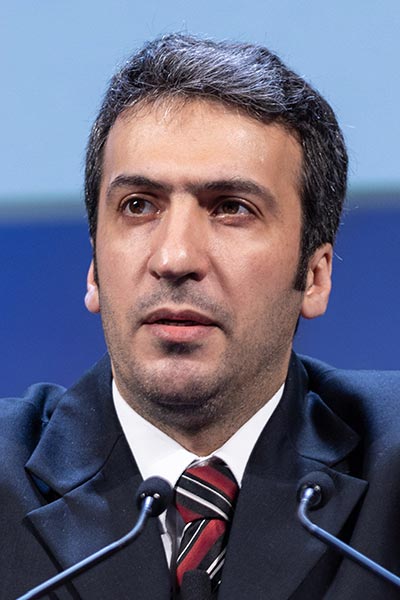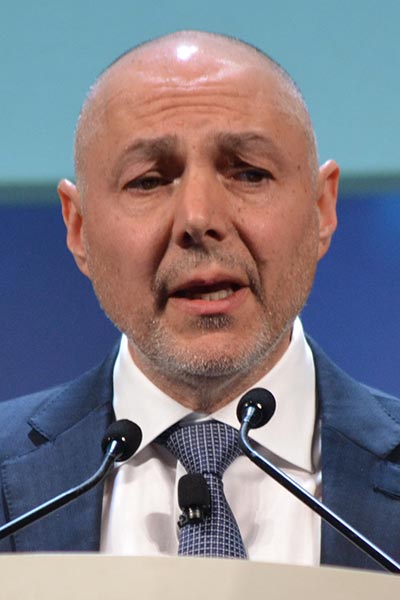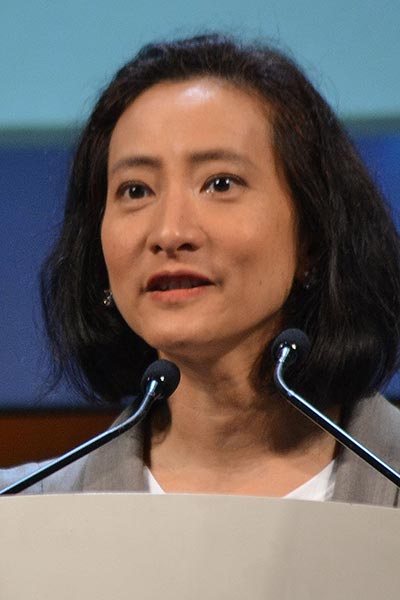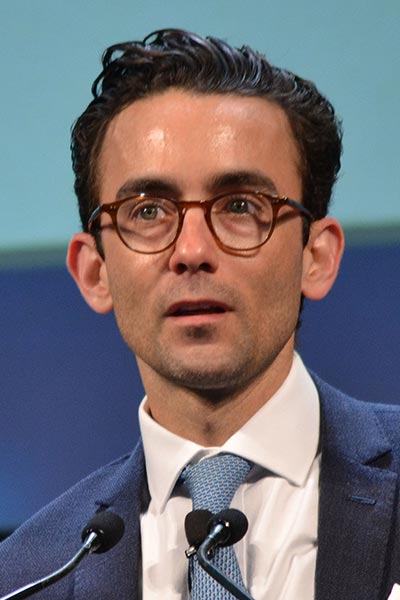Researchers report on promising novel antitumor strategies in early-phase clinical trials
During the Annual Meeting’s third clinical trials plenary session, Promising Novel Antitumor Strategies in Early Phase Clinical Trials, researchers showcased four antitumor treatments that have shown early promise. Here’s a look at the trials reported in the session, which was originally presented Monday, April 17, and can be viewed on the virtual meeting platform by registered Annual Meeting participants through July 19, 2023.
First-in-human allogeneic anti-CD70 CAR T-cell therapy in RCC

Chimeric antigen receptor (CAR) T-cell therapy has revolutionized the treatment of hematopoietic cancers, but the same approach has largely failed in solid tumors.
TRAVERSE is the first-in-human trial of ALLO-316, an off-the-shelf allogeneic CAR T-cell therapy targeting CD70 expressed in metastatic renal cell carcinoma (RCC). In the phase I trial, ALLO-316 showed encouraging antitumor activity, reported Samer A. Srour, MD, Assistant Professor of Stem Cell Transplantation at The University of Texas MD Anderson Cancer Center.
“We observed an overall response rate (ORR) of 17 percent and a disease control rate (DCR) of 89 percent,” Srour said. “We did not notice any safety events outside what we would expect in autologous CAR T treatment,” Srour noted.
CD70 is a promising cancer target expressed in up to 80 percent of RCC, as well as on other hematological and solid cancers, but has limited expression in normal tissue. ALLO-316 consists of T cells engineered to express an anti-CD70 CAR. In addition, the endogenous T-cell receptor and the cell surface protein CD52 are depleted to reduce the risk of graft-versus-host disease and to facilitate conditioning. ALLO-316 includes a CD20 mimotope-based off-switch to enable effective elimination of the CAR T cell in the presence of rituximab.
TRAVERSE used a 3+3 design to explore four cell dose levels ranging from 40×106 to 240×106 CAR T cells, with one of two conditioning regimens for lymphodepletion, fludarabine (F) + cyclophosphamide (C), or FC + ALLO-647, an anti-CD52 monoclonal antibody.
The trial treated a total of 19 patients over 56 days with 36 months of planned follow-up. After enrollment, patients were able to initiate conditioning after a median of five days. Patients had a median age of 62 years and were predominantly male. All had stage IV disease and had received multiple prior therapies. The median follow-up was 7.8 months.
There were no unexpected toxicities, Srour said. Fifty-eight percent of patients had cytokine release syndrome (CRS) but only one patient had grade 3 or higher CRS. Forty-two percent of patients had infections, 21 percent of which were grade 3 or higher, and no maximum tolerable dose was seen.
Patients whose tumors were CD70+ at entry had the most robust response, including 100 percent DCR, Srour reported. DCR in the entire cohort was 89 percent. Patients showed robust CAR T-cell expansion, persistence, and tumor trafficking.
Expansion cohorts are planned for later in 2023, Srour said, with the potential inclusion of other CD70+ tumor types.
Promising bispecific antibody for HNSCC

Petosemtamab, a bispecific antibody targeting both endothelial growth factor receptor (EGFR) and leucine-rich repeat-containing G-protein coupled receptor 5 (LGR5), showed significant activity in patients with head and neck squamous cell carcinoma (HNSCC), reported Ezra Cohen, MD, Chief of Hematology-Oncology at the University of California, San Diego, Moores Cancer Center.
HNSCC is the sixth most common cancer worldwide and has a dismal prognosis in the metastatic setting.
“There is no standard-of-care for metastatic HNSCC,” Cohen said. “We desperately need new approaches. Overall survival for advanced HNSCC is about six months.”
EGFR is a familiar cancer target and is overexpressed in up to 90 percent of HNSCC tumors. A less familiar target, LGR5, is overexpressed in up to 89 percent of HNSCC, Cohen said.
The dose escalation portion of a phase I/II study pointed to twice-monthly dosing of 1500 mg of petosemtamab with no dose-limiting toxicities, Cohen reported. A total of 49 patients were enrolled and 43 were evaluated in the study.
Patients had a median age of 63 years, and 78 percent were male. About a third had oropharynx tumors, another third had oral cavity tumors, and another third had tumors in other locations. All patients had progressed after a median of two previous therapies.
Results were encouraging, Cohen said. The overall response rate was 37.2 percent, DCR was 72.1 percent, and the median time to response was 1.8 months. Median duration of response (DOR) was six months, median progression-free survival (PFS) was 5.3 months, and median overall survival (OS) was 11.5 months.
Bispecific antibody successful against relapsed/refractory MM

REGN5459, a bispecific antibody to B-cell maturation antigen (BCMA) and CD3, has shown early, deep, and durable anticancer activity with an acceptable safety profile in patients with relapsed/refractory multiple myeloma (MM), said Attaya Suvannasankha, MD, who reported results from the first-in-human phase I/II study of REGN5459 in relapsed/refractory MM.
“Patients at the highest doses had an overall response rate of 90.5 percent,” said Suvannasankha, Associate Professor of Clinical Medicine at Indiana University Simon Cancer Center. “Across all dose levels, we saw an ORR of 65.1 percent. Responses were early, a median of 0.8 months, and deepened with time.” Median duration of response was not reached after a median follow-up of nine months.
The trial used a fixed, step-up dosing schedule to mitigate the risk of CRS, with doses from 3 mg to 900 mg. There was one dose-limiting toxicity at 900 mg, with 480 mg selected as the recommended phase II dose.
The median age of the 43 study participants was 67 years, with a slight predominance of females. All had active MM and had progressed on at least three prior lines of therapy.
All patients experienced adverse events, with 74.4 percent grade 3 or 4. Just over half of the patients, 53.5 percent, had grade 1-3 CRS. No patients had grade 3 or 4 CRS.
“The estimated probability of maintaining response at 12 months is 78.1 percent,” Suvannasankha said. “We saw manageable safety and very promising efficacy in a very heavily pretreated population. Further development of REGN5459 is under consideration.”
Fractionated dosing of PSMA-based radiotherapy shows preliminary efficacy, safety

Radionuclide therapy targeting prostate-specific membrane antigen (PSMA) has become the standard of care for metastatic castration-resistant prostate cancer (mCRPC). The radionuclide approved by the U.S. Food and Drug Administration combines a small molecule ligand with a beta-emitting payload.
The therapy is highly effective, noted Jones T. Nauseef, MD, PhD, Assistant Professor of Hematology and Medical Oncology at Weill Cornell Medicine Meyer Cancer Center. But small molecules have short circulation times, wide diffusion of multiple tissues, and toxicities, particularly in the salivary glands. And beta radiation has a range of several millimeters, which can increase off-target exposure.
One solution is to redesign the radionuclide approach using a monoclonal antibody and an alpha-emitting payload. Monoclonal antibodies have long circulation times and more limited diffusion, which helps minimize off-target exposure in the salivary glands. An alpha-emitting radionuclide is more potent and only penetrates about three cell diameters, which could reduce off-target exposure.
The phase I fractionated dose escalation study of 225Ac-J591 used four doses from 90 KBq/kg to 130 KBq/kg. The 23 mCRPC patients in the study had a median age of 73.5 years and a median PSA level of 25.78 ng/mL. Most had metastases to bone (83 percent) and/or lymph nodes (50 percent).
Grade 4 thrombocytopenia was observed in 13 percent of patients; all other adverse events were grade 3 or lower.
Ninety-five percent of patients who received a single dose of 225Ac-J591 experienced a reduction in PSA levels, Nauseef reported. Sixteen of the 23 patients experienced a PSA reduction of at least 50 percent, and six patients experienced a reduction of at least 90 percent. Similar results were observed when efficacy was evaluated by circulating tumor cells or by imaging.
More from the AACR Annual Meeting 2025
View a photo gallery of scenes from Chicago, continue the conversation on social media using the hashtag #AACR25, and read more coverage in AACR Annual Meeting News.

